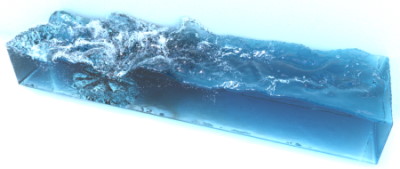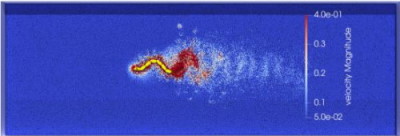Publications
Fast Octree Neighborhood Search for SPH Simulations

We present a new octree-based neighborhood search method for SPH simulation. A speedup of up to 1.9x is observed in comparison to state-of-the-art methods which rely on uniform grids. While our method focuses on maximizing performance in fixed-radius SPH simulations, we show that it can also be used in scenarios where the particle support radius is not constant thanks to the adaptive nature of the octree acceleration structure.
Neighborhood search methods typically consist of an acceleration structure that prunes the space of possible particle neighbor pairs, followed by direct distance comparisons between the remaining particle pairs. Previous works have focused on minimizing the number of comparisons. However, in an effort to minimize the actual computation time, we find that distance comparisons exhibit very high throughput on modern CPUs. By permitting more comparisons than strictly necessary, the time spent on preparing and searching the acceleration structure can be reduced, yielding a net positive speedup. The choice of an octree acceleration structure, instead of the uniform grid typically used in fixed-radius methods, ensures balanced computational tasks. This benefits both parallelism and provides consistently high computational intensity for the distance comparisons. We present a detailed account of high-level considerations that, together with low-level decisions, enable high throughput for performance-critical parts of the algorithm.
Finally, we demonstrate the high performance of our algorithm on a number of large-scale fixed-radius SPH benchmarks and show in experiments with a support radius ratio up to 3 that our method is also effective in multi-resolution SPH simulations.
» Show BibTeX
@ARTICLE{ FWL+22,
author= {Jos{\'{e}} Antonio Fern{\'{a}}ndez-Fern{\'{a}}ndez and Lukas Westhofen and Fabian L{\"{o}}schner and Stefan Rhys Jeske and Andreas Longva and Jan Bender },
title= {{Fast Octree Neighborhood Search for SPH Simulations}},
year= {2022},
journal= {ACM Transactions on Graphics (SIGGRAPH Asia)},
publisher= {ACM},
volume = {41},
number = {6},
pages= {13}
}
A Survey on SPH Methods in Computer Graphics

Throughout the past decades, the graphics community has spent major resources on the research and development of physics simulators on the mission to computer-generate behaviors achieving outstanding visual effects or to make the virtual world indistinguishable from reality. The variety and impact of recent research based on Smoothed Particle Hydrodynamics (SPH) demonstrates the concept's importance as one of the most versatile tools for the simulation of fluids and solids. With this survey, we offer an overview of the developments and still-active research on physics simulation methodologies based on SPH that has not been addressed in previous SPH surveys. Following an introduction about typical SPH discretization techniques, we provide an overview over the most used incompressibility solvers and present novel insights regarding their relation and conditional equivalence. The survey further covers recent advances in implicit and particle-based boundary handling and sampling techniques. While SPH is best known in the context of fluid simulation we discuss modern concepts to augment the range of simulatable physical characteristics including turbulence, highly viscous matter, deformable solids, as well as rigid body contact handling. Besides the purely numerical approaches, simulation techniques aided by machine learning are on the rise. Thus, the survey discusses recent data-driven approaches and the impact of differentiable solvers on artist control. Finally, we provide context for discussion by outlining existing problems and opportunities to open up new research directions.
@article {KBST2022,
journal = {Computer Graphics Forum},
title = {{A Survey on SPH Methods in Computer Graphics}},
author = {Koschier, Dan and Bender, Jan and Solenthaler, Barbara and Teschner, Matthias},
year = {2022},
volume ={41},
number = {2},
publisher = {The Eurographics Association and John Wiley & Sons Ltd.},
ISSN = {1467-8659},
DOI = {10.1111/cgf.14508}
}
Gazebo Fluids: SPH-based simulation of fluid interaction with articulated rigid body dynamics

Physical simulation is an indispensable component of robotics simulation platforms that serves as the basis for a plethora of research directions. Looking strictly at robotics, the common characteristic of the most popular physics engines, such as ODE, DART, MuJoCo, bullet, SimBody, PhysX or RaiSim, is that they focus on the solution of articulated rigid bodies with collisions and contacts problems, while paying less attention to other physical phenomena. This restriction limits the range of addressable simulation problems, rendering applications such as soft robotics, cloth simulation, simulation of viscoelastic materials, and fluid dynamics, especially surface swimming, infeasible. In this work, we present Gazebo Fluids, an open-source extension of the popular Gazebo robotics simulator that enables the interaction of articulated rigid body dynamics with particle-based fluid and deformable solid simulation. We implement fluid dynamics and highly viscous and elastic material simulation capabilities based on the Smoothed Particle Hydrodynamics method. We demonstrate the practical impact of this extension for previously infeasible application scenarios in a series of experiments, showcasing one of the first self-propelled robot swimming simulations with SPH in a robotics simulator.
@InProceedings{ABA22,
author = {Emmanouil Angelidis and Jan Bender and Jonathan Arreguit and Lars Gleim and Wei Wang and Cristian Axenie and Alois Knoll and Auke Ijspeert},
booktitle = {IEEE/RSJ International Conference on Intelligent Robots and Systems (IROS)},
title = {Gazebo Fluids: SPH-based simulation of fluid interaction with articulated rigid body dynamics},
organization={IEEE},
year = {2022}
}
Quantitative Evaluation of SPH in TIG Spot Welding

While the application of the Smoothed Particle Hydrodynamics (SPH) method for the modeling of welding processes has become increasingly popular in recent years, little is yet known about the quantitative predictive capability of this method. We propose a novel SPH model for the simulation of the tungsten inert gas (TIG) spot welding process and conduct a thorough comparison between our SPH implementation and two Finite Element Method (FEM) based models. In order to be able to quantitatively compare the results of our SPH simulation method with grid based methods we additionally propose an improved particle to grid interpolation method based on linear least-squares with an optional hole-filling pass which accounts for missing particles. We show that SPH is able to yield excellent results, especially given the observed deviations between the investigated FEM methods and as such, we validate the accuracy of the method for an industrially relevant engineering application.
@Article{JSS+22,
author = {Stefan Rhys Jeske and Marek Sebastian Simon and Oleksii Semenov and Jan Kruska and Oleg Mokrov and Rahul Sharma and Uwe Reisgen and Jan Bender},
journal = {Computational Particle Mechanics},
title = {Quantitative evaluation of {SPH} in {TIG} spot welding},
year = {2022},
month = {apr},
doi = {10.1007/s40571-022-00465-x},
publisher = {Springer Science and Business Media {LLC}},
}
Application and Benchmark of SPH for Modeling the Impact in Thermal Spraying

The properties of a thermally sprayed coating, such as its durability or thermal conductivity depend on its microstructure, which is in turn directly related to the particle impact process. To simulate this process we present a 3D Smoothed Particle Hydrodynamics (SPH) model, which represents the molten droplet as an incompressible fluid, while a semi-implicit Enthalpy-Porosity method is applied for modeling the phase change during solidification. In addition, we present an implicit correction for SPH simulations, based on well known approaches, from which we can observe improved performance and simulation stability. We apply our SPH method to the impact and solidification of Al2O3 droplets onto a substrate and perform a comprehensive quantitative comparison of our method with the commercial software Ansys Fluent using the Volume of Fluid (VOF) approach, while taking identical physical effects into consideration. The results are evaluated in depth and we discuss the applicability of either method for the simulation of thermal spray deposition. We also evaluate the droplet spread factor given varying initial droplet diameters and compare these results with an analytic expression from previous literature. We show that SPH is an excellent method for solving this free surface problem accurately and efficiently.
@Article{JBB+22,
author = {Stefan Rhys Jeske and Jan Bender and Kirsten Bobzin and Hendrik Heinemann and Kevin Jasutyn and Marek Simon and Oleg Mokrov and Rahul Sharma and Uwe Reisgen},
journal = {Computational Particle Mechanics},
title = {Application and benchmark of {SPH} for modeling the impact in thermal spraying},
year = {2022},
month = {jan},
doi = {10.1007/s40571-022-00459-9},
publisher = {Springer Science and Business Media {LLC}},
}
Previous Year (2021)

